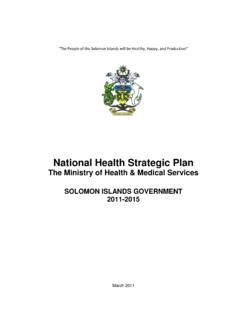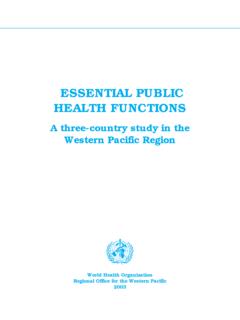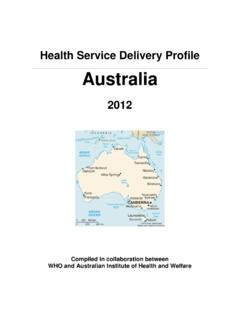Transcription of MODULE 1: Identifying the problem and the desired outcome
1 IiiiiMODULE 1: Identifying the problem and the desired outcomeiiiiiiiiiiMODULE 1: Identifying the problem and the desired outcomeiiiiiiiiiiiiiiiMODULE 1: Identifying the problem and the desired outcomeCONTENTSCONTENTSCONTENTSCONTENTSC ONTENTSMODULE 1: Identifying THE problem ANDTHE desired OUTCOMEO bjectives1 Session 12 introduction to this module2 The problem2 problem description3 Analysing the problem4 Prioritizing the problem5 Assessing your strengths and weaknesses (SWOT) 6 Force field analysis7 Session 28 introduction to gathering evidence8 The evidence8 Accessing information: search focus10 Search preparation11 Case development12 Potential source of information: the information14sources auditAppraising the evidence15 Applying the evidence16 References17 Information sheet - Data sources18 Facilitator s Guide - Defining the problem22 Exercise sheet - problem description tool24 Exercise sheet - Brainstorming26 Exercise sheet - Prioritization matrix tool28ivivivivivMODULE 1: Identifying the problem and the desired outcomeExercise sheet - SWOT analysis30 Exercise sheet - Force field analysis32 Facilitator s Guide - Gathering evidence34 Exercise sheet - Search focus tool36 Exercise sheet - Search preparation tool37 Exercise sheet - Case development tool39 Exercise sheet - Information source audit tool41 Exercise sheet - Information analysis tool43 Exercise sheet - Case documentation tool4511111 MODULE 1.
2 Identifying the problem and the desired outcomeMMMMMODULEODULEODULEODULEODULE 1 1 1 1 1 Identifying THE problem ANDTHE desired OUTCOMEO bjectivesObjectivesObjectivesObjectivesO bjectivesUpon completing this session, the reader should be able to:Identify and define the problemUse a problem solving approach to generate a solutionCarry out a force field and SWOT analysisFind, appraise and apply the evidence55555555555555555555 MODULE 2 Identifying and Analysingthe Stakeholders andNetworksMODULE 5 Managing Communicationand the Change ProcessMODULE 3 Understanding theContextual EnvironmentMODULE 1 Identifying the Problemand the desired OutcomeMODULE 6 Monitoring and Evaluatingthe ProjectMODULE 4 Understanding the Policy,Political and Decision-Making ProcessesTTTTTT22222 MODULE 1: Identifying the problem and the desired outcomeSession 1 Session 1 Session 1 Session 1 Session 1 introduction to thismoduleDefining a problem so that it is relevant to decision-makersbegins with awareness that a problem exists or, morespecifically, that there is a difference between the actual anddesired state of affairs.
3 It is essential for the advocate forchange to be very clear about what the problem really is. Togo forward not being clear or not having analysed the problemwill send you, the advocate for change, on the wrong an analysis of the problem , you will be ready toconsider the range of solutions available to you. This taskwill be aided by the use of a number of tools and this modulewill provide you with some examples and problemProblem identification is not a simple task. Also, one person sproblem is another person s satisfactory state of affairs. Aproblem occurs when there is a difference between whatshould be and what is , between the ideal and the actualsituation. A problem : expresses the difference between the hoped for and theactual situation; and is directly or indirectly related to the health of something can be said to be a problem , you have to: be aware of the discrepancy; be under pressure to take action; and have the resources necessary to take do you become aware you have a discrepancy?
4 Youhave to make a comparison between the current state ofaffairs and some standard. What is that standard? It canbe past performance, previously set goals, or theperformance of some other unit within the organization or inother problem must also be such that it puts some type ofpressure to act. Pressure might include organizationalpolicies, deadlines, financial crises, complaints, expectationsfrom management, a proposed change or a continuingcommunity :A problem is a discrepancybetween an existing and adesired state of 1: Identifying the problem and the desired outcomeFinally, you are not likely to describe something as a problemif you think that you do not have the authority, budget,information or other resources necessary to act on it.
5 Whenyou believe you have a problem and are under pressure toact, but feel you have inadequate resources, you usuallydescribe the situation as one in which unrealistic expectationsare being placed on descriptionBefore attempting to solve a problem , you need to describe itin detail. You do this so you can understand how the problemaffects the process being examined, such as delivery of ahealth service to a community. (See Exercise Sheet )Example: Health Centre Case StudyA health centre receives complaints from users regarding the qualityof the services. A discrepancy exists between the numbers ofcomplaints currently being received in comparison to the previous number of complaints is now reaching a volume that frequently does the problem occur?Verbal and written complaints are being received on a daily does it generally occur?
6 It appears to have started following a reduction in staffing does it generally occur?The location is not relevant to this is most affected?Obviously the users are, but so are the staff as they are becoming quiteagitated by the complaints and the workload they are problem can therefore be summarized as:Patient dissatisfaction, affecting both patients andstaff, which appears to have started following a reductionin a problem that you have experienced recently and usingthe problem Description Tool (Exercise Sheet ) describe theproblem more 1: Identifying the problem and the desired outcomeAnalysing the problemNow that you have described the problem , you can move onto analysing it. To act most effectively, you should analyseits causes and prioritize the most important factors.
7 Actingon those critical causal factors will solve most of the is suggested that you use the brainstorming technique.(See Exercise Sheet ).Example:You are concerned about the quality of services provided at the healthcentre in which you work. You need assistance in defining and analysingthe problems. As a first step in Identifying the problems that are affectingthe quality of the services offered through a health centre, you canconduct a brainstorming session with users chosen randomly from thehealth centre. You are in charge of the brainstorming some users in a room together with members of staff, and ask themthe following question: In your opinion, what are the problems of qualitythat the health centre is facing? You ask them to take a few minutes tothink to themselves about this issue, and assure them that there are noright or wrong , each participant states his or her ideas, one at a time, and youwrite the ideas on a large piece of paper so everyone can see participants add to the list when new ideas come to mind during thediscussion.
8 You group all the ideas together, and ask the group to clarifyones that are not clear. After the list of ideas is finished, the groupdiscusses the ideas together. You lead them to consensus on whichideas to keep and which to result of the brainstorming session is a final list of the problems thatare impacting the quality of the services provided at the health list included: no appointments on Tuesdays or Wednesday afternoons not enough chairs in the waiting room the waiting area is noisy and crowded delays in registering on arrival not enough nursing staff have to wait too long to get an appointment long waiting time at appointments patients feel that they are not treated with respectExerciseTaking the problem you have described in the previous exercise, usethe brainstorming technique to assess the causes of the problem .
9 Usethe Brainstorming Tool (Exercise Sheet ) and if you cannot access agroup, try brainstorming on your 1: Identifying the problem and the desired outcomePrioritizing theproblemOnce you have analysed the causes of a problem you canuse a Prioritization Matrix to prioritize the important causes(see Exercise Sheet ).By using this method of prioritizing problems, you are able tolook at the data and determine which problems are mostimportant according to this group of patients and staff. Thegeneral view of the group is that the lack of nursing staff is awidely perceived problem . The second most importantproblem is perceived as being the long wait to get anappointment and the third most important problem is the longwaiting time at the is an example of the results you might achieve whenyou have completed Exercise Sheet Total pointsNo appointments onTuesday afternoons692445138 Not enough chairs inthe waiting room253786148 The waiting room isnoisy and crowded322674132 Delays in registeringon arrival524248142 Not enough nursingstaff768835199 Long waiting timeat appointments416946156 Long wait to getan appointment557948182 ExerciseTaking the problem you have accurately described and analysed inthe previous exercise, use the Prioritization Matrix Tool (Exercise )
10 To prioritize the important have now described and analysed your problem , andprioritized the causes. The next step is to start planningyour way forward. Given that you have decided to be thechange agent and advocate for change, it is useful to assessyour strengths and weaknesses and consider where youropportunities and threats are going to come 1: Identifying the problem and the desired outcomeAssessing yourstrengths andweaknesses (SWOT)SWOT analysis is a very effective tool for Identifying yourstrengths and weaknesses, and for examining theopportunities and threats you may face. Carrying out ananalysis using the SWOT framework will help you to focusyour activities on areas where you are strong, and wherethe greatest opportunities lie (see Exercise Sheet ).















